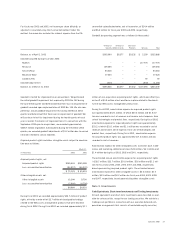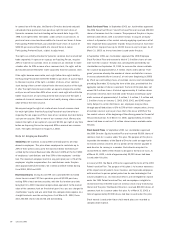Symantec 2003 Annual Report Download - page 68
Download and view the complete annual report
Please find page 68 of the 2003 Symantec annual report below. You can navigate through the pages in the report by either clicking on the pages listed below, or by using the keyword search tool below to find specific information within the annual report.
66 Symantec 2003
The principal components of deferred tax assets were as follows:
March 31,
(IN THOUSANDS) 2003 2002
Deferred tax assets:
Tax credit carryforwards $8,712 $1,618
Net operating loss carryforwards of
acquired companies 43,874 25,029
Other accruals and reserves not currently
tax deductible 49,485 37,421
Deferred revenue 21,000 9,736
Loss on investments not currently tax
deductible 10,375 10,199
Other 7,117 10,675
140,563 94,678
Valuation allowance (5,111) (5,111)
Deferred tax assets 135,452 89,567
Deferred tax liabilities:
Acquired intangible assets (13,010) (11,353)
Tax over book depreciation (8,012) (1,697)
Unremitted earnings of foreign subsidiaries (14,160) (1,689)
Net deferred tax assets $100,270 $74,828
Realization of a significant portion of approximately $100.3 million of
net deferred tax assets is dependent upon our ability to generate suffi-
cient future taxable income and the implementation of tax planning
strategies. We believe it is more likely than not that the net deferred tax
assets will be realized based on historical earnings, expected levels of
future taxable income in the U.S. and certain foreign jurisdictions, and
the implementation of tax planning strategies. The valuation allowance
remained unchanged during fiscal 2003 and 2002.
As of March 31, 2003, we have tax credit carryforwards of approximately
$8.7 million that expire in fiscal 2004 through 2008. In addition, we
have net operating loss carryforwards attributable to various acquired
companies of approximately $111.4 million that expire in fiscal 2011
through 2022. These net operating loss carryforwards are subject to an
annual limitation under Internal Revenue Code §382, but are expected
to be fully realized.
Pretax income from international operations was approximately $225.4
million, $168.4 million and $144.9 million for fiscal 2003, 2002 and
2001, respectively.
No provision has been made for federal or state income taxes on
approximately $490.6 million of cumulative unremitted earnings of
certain of our foreign subsidiaries as of March 31, 2003, since we plan
to indefinitely reinvest these earnings. As of March 31, 2003, the unrec-
ognized deferred tax liability for these earnings was approximately
$127.6 million.
Note 15. Litigation
On March 28, 2003, Ronald Pearce filed a lawsuit on behalf of himself
and purportedly on behalf of the general public of the United States and
Canada in the California Superior Court, Santa Clara County, alleging
violations of California Business and Professions Code section 17200
and false advertising in connection with our WinFax Pro product. The
complaint seeks damages and injunctive and other equitable relief,
as well as costs and attorney fees. We intend to defend the action
vigorously.
On February 27, 2003, PowerQuest Corporation filed a lawsuit against
us in the United States District Court, District of Utah, alleging that
our Ghost product infringes a patent owned by them. The complaint
seeks damages and injunctive relief. We intend to defend the action
vigorously.
On February 7, 2003, Cathy Baker filed a lawsuit against us, Microsoft
and two retailers in the California Superior Court, Marin County, pur-
portedly on behalf of the general public of California and of a class of
certain purchasers of software products. An amended complaint filed
in May 2003 adds Greg Johnson as plaintiff and Adobe Systems and
another retailer as defendants. The complaint alleges that our refund
policies violate consumer warranty and unfair business practice laws.
The lawsuit seeks damages, rescission and injunctive relief, as well as
costs and attorney fees. We intend to defend the action vigorously.
On November 29, 2002, William Pereira filed a purported class action
lawsuit against a local retailer and us in the Supreme Court of New York,
New York County, alleging breach of contract and deceptive business
practices in connection with rebates offered by us. The complaint was
served March 26, 2003. The complaint seeks damages, costs and attor-
ney fees. We intend to defend the action vigorously.
On June 14, 2002, Hark Chan and Techsearch LLC filed a lawsuit
against us in the United States District Court for the Northern District
of California, alleging that unspecified products sold on CD-ROM with
Internet hyperlinks and/or with the LiveUpdate feature infringe a patent
owned by Techsearch. Subsequently, IP Innovation LLC was added as a
plaintiff. The lawsuit requests damages, injunctive relief, costs and
attorney fees. We intend to defend the action vigorously.
In May 2002, Craig Hughes filed a lawsuit in Utah state court, purport-
edly on behalf of a class of persons located in Utah who he asserts
received unsolicited commercial email from us. The complaint alleges
violation of Utah’s recently enacted Unsolicited Commercial Email Act.
The lawsuit requests damages, costs and attorney fees. In January
2003, the parties to the lawsuit submitted to the court a stipulated
request for dismissal.
On December 23, 1999, Altiris Inc. filed a lawsuit against us in the
United States District Court, District of Utah, alleging that unspecified
Symantec products including Norton Ghost Enterprise Edition, infringed
a patent owned by Altiris. The lawsuit requests damages, injunctive
relief, costs and attorney fees. In October 2001, a stipulated judgment
of non-infringement was entered following the court’s ruling construing
the claims of the Altiris patent, and in February 2003, the Court of






















